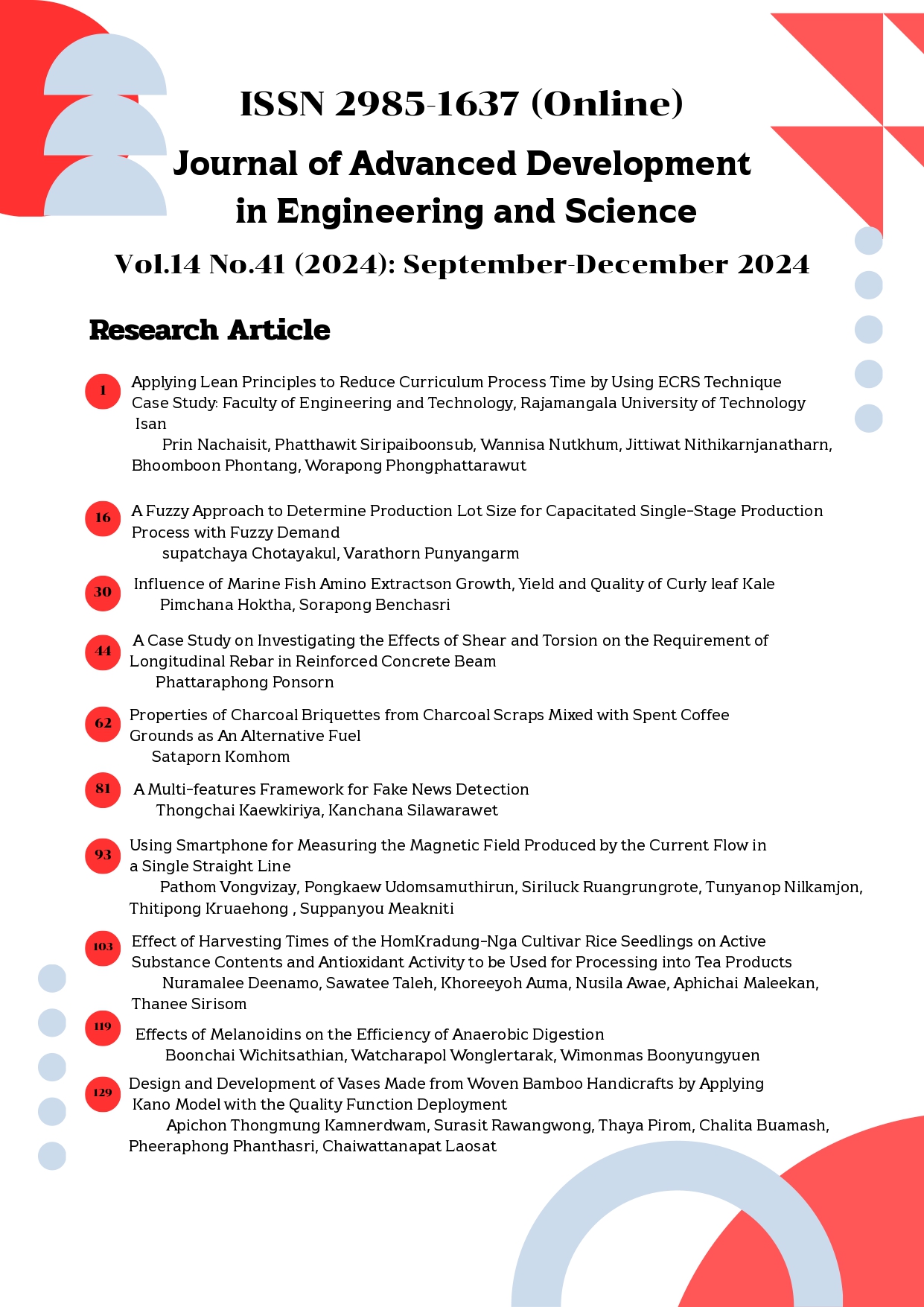ผลของอายุการเก็บเกี่ยวต้นอ่อนข้าวพันธุ์หอมกระดังงาต่อปริมาณสารสำคัญและฤทธิ์ต้านอนุมูลอิสระเพื่อใช้ใน การแปรรูปเป็นผลิตภัณฑ์ชา
Main Article Content
บทคัดย่อ
การศึกษานี้มีวัตถุประสงค์เพื่อหาปริมาณสาระสำคัญ ได้แก่ สารฟีนอลิกรวม สารฟลาโวนอยด์และเพื่อวิเคราะห์ฤทธิ์ต้านอนุมูลอิสระของต้นอ่อนข้าวพันธุ์หอมกระดังงาที่อายุการเก็บเกี่ยวต่างกัน ได้แก่ 5 10 15 20 25 และ 30 วันหลังย้ายปลูก จากนั้นนำต้นอ่อนข้าวมาอบที่อุณหภูมิ 60 องศาเซลเซียสเป็นเวลา 24 ชั่วโมงแล้วนำมาบดให้ละเอียดและสกัดสารตัวอย่างแบบแช่เพียงครั้งเดียวในตัวทำละลายต่างกัน 2 ชนิดคือน้ำร้อน (อุณหภูมิ100 องศาเซลเซียส) และเอทานอลความเข้มข้นร้อยละ 80 โดยปริมาตร (อุณหภูมิห้อง) วางแผนการทดลองแบบสุ่มสมบูรณ์ (completely randomized design, CRD) จำนวน 3 ซ้ำ เมื่อวิเคราะห์การทดลองด้วยเทคนิคสเปกโทรโฟโตเมตรี พบว่าอายุการเก็บเกี่ยวของต้นอ่อนข้าวพันธุ์หอมกระดังงาและชนิดของตัวทำละลายที่ใช้ในการสกัดมีผลต่อปริมาณสารสำคัญอย่างมีนัยสำคัญทางสถิติ (p<0.05) โดยต้นอ่อนข้าวพันธุ์หอมกระดังงาที่อายุการเก็บเกี่ยว 10 วันและสกัดด้วยเอทานอล ความเข้มข้น 80% (v/v) มีปริมาณสารฟีนอลิกรวมและฟลาโวนอยด์สูงสุดเท่ากับ 13.82±0.06 mg of GAE/g.dw และ17.50±0.11 mg of quercetin equivalent/g.dw ตามลำดับ ส่วนความสามารถในการทดสอบฤทธิ์ต้านอนุมูลอิสระด้วยวิธี 2,2-diphenyl-1-picrylhydrazyl (DPPH) radical scavenging activity มีค่า IC50 เท่ากับ 226.07 mg/mL ดังนั้นจากผลการวิจัยนี้พบว่าการเลือกต้นอ่อนข้าวที่มีอายุการเก็บเกี่ยวที่เหมาะสมมีผลต่อปริมาณสารฟีนอลิกรวมฟลาโวนอยด์และประสิทธิภาพการต้านอนุมูลอิสระซึ่งสามารถนำข้อมูลนี้ไปใช้ในการพัฒนาผลิตภัณฑ์ชาต้นอ่อนข้าวพันธุ์หอมกระดังงาเพื่อสุขภาพต่อไป
Article Details

อนุญาตภายใต้เงื่อนไข Creative Commons Attribution-NonCommercial-NoDerivatives 4.0 International License.
เนื้อหาและข้อมูลในบทความที่ลงตีพิมพ์ใน Journal of Advanced Development in Engineering and Science ถือเป็นข้อคิดเห็นและความรับผิดชอบของผู้เขียนบทความโดยตรง ซึ่งกองบรรณาธิการวารสารไม่จำเป็นต้องเห็นด้วยหรือร่วมรับผิดชอบใดๆ
บทความ ข้อมูล เนื้อหา ฯลฯ ที่ได้รับการตีพิมพ์ในJournal of Advanced Development in Engineering and Science ถือเป็นลิขสิทธิ์ของ Journal of Advanced Development in Engineering and Science หากบุคคลหรือหน่วยงานใดต้องการนำทั้งหมดหรือส่วนหนึ่งส่วนใดไปเผยแพร่ต่อหรือเพื่อกระทำการใดๆ จะต้องได้รับอนุญาตเป็นลายลักษณ์อักษรจาก Journal of Advanced Development in Engineering and Scienceก่อนเท่านั้น
เอกสารอ้างอิง
Crystal, E., & Whittlesey, P. (2004). The Role of Rice in Southeast Asia. Education About Asia, 9(3), 50-55.
USDA. (2024). Grain: World Markets and Trade. Available from https://apps.fas.usda.gov/ psdonline/circulars/grain.pdf. Accessed date: 20 January 2024.
Sudtasarn, G., et al. (2008). Research and development of green tea from fragrant rice seedlings. In Rice and Temperate Cereal Crops Annual Conference 2008 (p.398-406). 8 – 10 April, 2008, Chonburi, Thailand. (in Thai)
Shori, A. B. (2015). Screening of antidiabetic and antioxidant activities of medicinal plants. Journal of Integrative Medicine, 13(5), 297-305.
Goufo, P., & Trindade, H. (2014). Rice antioxidants: phenolic acids, flavonoids, anthocyanins, proanthocyanidins, tocopherols, tocotrienols, ‐oryzanol, and phytic acid. Food science and nutrition, 2(2), 75-104.
Sang, S., et al. (2011). The chemistry and biotransformation of tea constituents. Pharmacological Research, 64(2), 87-99.
Zeng, Y., et al. (2018). Preventive and therapeutic role of functional ingredients of barley grass for chronic diseases in human beings. Oxidative medicine and cellular longevity, 2018, 232080.
Du, S., et al. (2021). Differential antioxidant compounds and activities in seedlings of two rice cultivars under chilling treatments. Frontiers in Plant Science, 12, 631421.
Intellectual Property Office of Prince of Songkla University. (2017). Production process of rice sprout powder supplemented with selenium minerals. Available from https:// piti-ipop.psu.ac.th/portfolio/Detail.aspx?id=384. Accessed date 11 August 2024. (in Thai)
Kaewnango, E., et al. (2014). Hawm Gra Dang Ngah, local rice promising lines in Narathiwat province. In Rice and Temperate Cereal Crops Annual Conference 2014 (p.105-117). 21 – 23 May, 2014, Rayong, Thailand. (in Thai)
Torres, A. M., et al. (1987). Total phenolics and high performance liquid chromatography of phenolic acids of avocado. Journal of Agricultural and Food Chemistry, 35, 921-925.
Zhishen J., et al. (1999). The determination of flavonoid contents in mulberry and their scavenging effects on superoxide radicals. Food Chemistry, 64(4), 555–559.
Singh, R.P., et al. (2002). Studies on the antioxidant activity of pomegranate (Punica granatum) peel and seed extracts using in vitro models. Journal of Agricaltural and Food Chemistry, 50(1), 81-86.
Siriphanich, J. (2006). Postharvest biology and plant senescence. Bangkok: Faculty of Agriculture, Kasetsart University. (in Thai)
Thongchuang, M., et al. (2022). Influence of harvesting period of three rice seedlings on DPPH radical scavenging activity. PKRU SciTech Journal, 6(1), 34-46. (in Thai)
Cevallos-Casals, B. A., & Cisneros-Zevallos, L. (2010). Impact of germination on phenolic content and antioxidant activity of 13 edible seed species. Food Chemistry, 119(4), 1485-1490.
Patra, B., et al. (2013). Transcriptional regulation of secondary metabolite biosynthesis in plants. Biochimica et Biophysica Acta, 1829(11), 1236-1247.
Randhir, R., et al. (2008). Effect of thermal processing on phenolics, antioxidant activity and health-relevant functionality of select grain sprouts and seedlings. Innovative Food Science and Emerging Technologies, 9(3), 355-364.
Lucioli, S. (2012). Anthocyanins: mechanism of action and therapeutic efficacy. In Capasso, A. (Ed.) Medicinal plants as antioxidant agents: Understanding their mechanism of action and therapeutic efficacy (p. 27-57). Kerala: Research Signpost.
Yang, Z., et al. (2016). Metabolome analysis of Oryza sativa (rice) using liquid chromatography-mass spectrometry for characterizing organ specificity of flavonoids with anti-inflammatory and anti-oxidant activity. Chemical and Pharmaceutical Bulletin, 64(7), 952-956.
Besson, E., et al. (1985). C-glycosylflavones from Oryza sativa. Phytochemistry, 24(5), 1061-1064.
Somporn, C., et al. (2018). The study of antioxidant capacity of green tea from rice seedlings. Rajabhat Agriculture Journal. 17(1), 27-33. (in Thai)
Verma, S., & Dubey, R. S. (2003). Lead toxicity induces lipid peroxidation and alters the activities of antioxidant enzymes in growing rice plants. Plant Science, 164(4), 645-655.
Calzuola, I., et al. (2004). Synthesis of antioxidants in wheat sprouts. Journal of agricultural and food chemistry, 52(16), 5201-5206.

